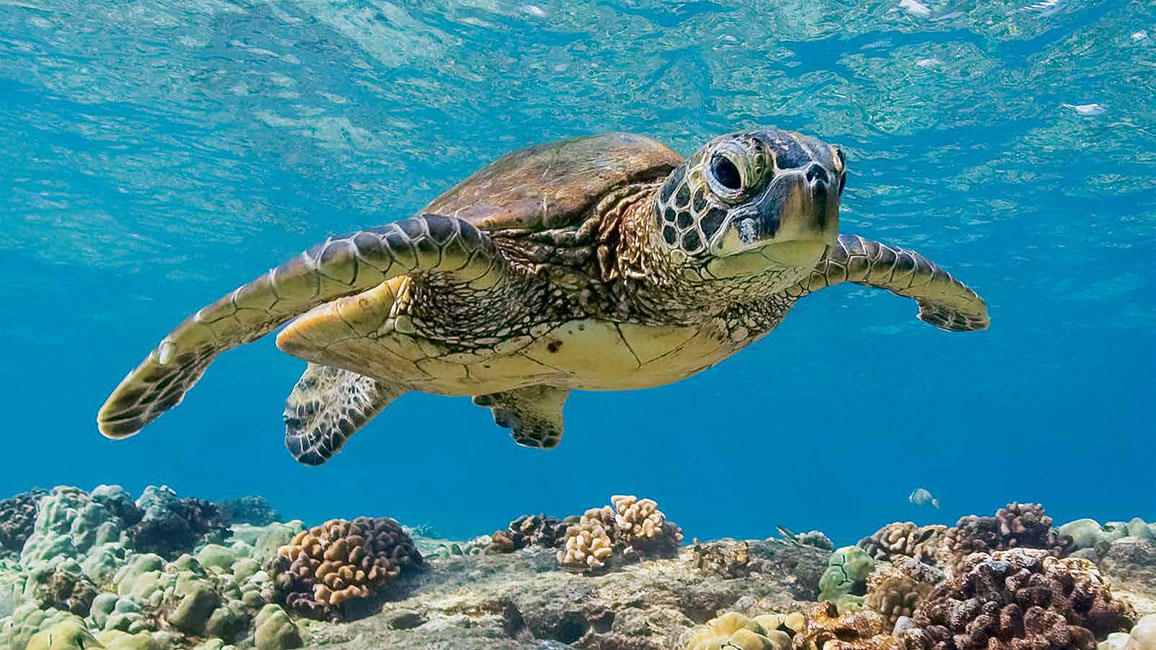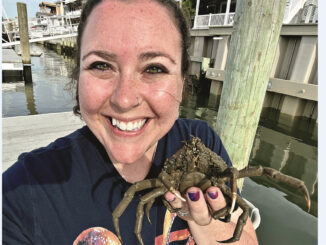
Sea Turtles
By Kathy KrankingScale-studded, flipper-flapping sea turtles began cruising their way through the ocean millions of years ago. And they’re still flapping.
Using its flippers as wings, this green sea turtle (above) “flies” gracefully through the water. There are seven species of sea turtles—the Kemp’s ridley, olive ridley, loggerhead, hawksbill, flatback, green, and leatherback—and they live in most ocean waters around the world. Some of these ancient reptiles are homebodies, hanging out in shallow coastal waters their whole lives. Others are wanderers that travel hundreds or even thousands of miles every year.
SHELL STORY
The first thing you notice about a sea turtle is its big, beautiful shell. And that brings up one of the main differences between sea turtles and most other kinds of turtles. Most turtles have shells like houses that they can pull their heads and limbs into. But a sea turtle can’t pull into its shell at all.
The shells of most kinds of sea turtles are made of bone and cartilage (the same bendable stuff your ears are made of.) These are covered with thin plates called scutes. But the leatherback’s shell is different. Its shell is made up of cartilage and tiny bones, but covering these is a layer of leathery skin.
SUITED FOR THE SEA
Sea turtles breathe air with lungs, just as you do. But they can hold their breath a lot longer than you ever could. The green sea turtle is the champ: It can stay underwater for as long as five hours! To swim, sea turtles use their strong, paddle-shaped front flippers. Their hind flippers help with steering.
But sea turtles are more than just great swimmers. Some of them are great divers. The leatherback can dive more than a thousand feet deep, looking for food. That’s more than the length of three football fields. And its deepest dives can be three times deeper than that!
CHOW TIME
Did someone mention food? Depending on the species, sea turtles can be animal-eaters, plant-eaters, or both. They don’t have teeth, but their beaks can give clues as to what they eat.
The sharp, strong beak of the loggerhead turtle, for example, is great for crushing the shells of crabs and shrimp. A hawksbill’s narrow, pointed beak helps it pull prey such as sponges from tight spaces in a coral reef.
A leatherback has a soft, delicate beak—just the thing for eating squishy foods such as jellyfish. And the green sea turtle’s jagged-edged beak is great for snipping sea grasses and scraping algae off coral and rocks.
The green sea turtle at top left grazes on algae growing on lava rock. A hawksbill sea turtle has a sharp point at the end of its narrow beak (above). The beak is similar to a bird’s beak, which is how the turtle got its name. Don’t worry—the leatherback sea turtle at top right isn’t crying. Like all sea turtles, it gets rid of extra salt in its body by squeezing salty fluid out of glands near its eyes. The leatherback is the biggest of all sea turtles. Check out the size of the one above right!
NESTING TIME
Sea turtles spend almost their entire lives in the water. But when it’s nesting time, the females come ashore to lay their eggs. They often return to the same beaches where they themselves hatched.
In most species, a female sea turtle comes ashore at night. She crawls clumsily along the sand. Next, she uses her flippers to dig a nest. Depending on the species, she lays from 50 to 200 round, white eggs. Then she covers them up with sand and lumbers back into the sea.
Later, the baby turtles hatch from the eggs and dig their way out of the nest. They crawl down to the shoreline, and then disappear into the waves.
TURTLE TROUBLES
Sea turtles have been around for millions of years. But these days they have their share of troubles. Many get caught in fishing nets or tangled in fishing lines. Turtles are also harmed by pollution, litter and oil spills. Lights along streets and on buildings near the beach can cause problems, too. Newly hatched babies can become lost and crawl toward the artificial light instead of toward the ocean where they belong.
Most kinds of female sea turtles come ashore alone to lay eggs. But olive ridley (above left) and Kemp’s ridley sea turtles come onto nesting beaches in huge numbers—sometimes in the thousands!
After digging a nest with her flippers, a female leatherback lays her eggs (1). She then covers the nest with sand (2). This newly hatched baby flatback (3) is digging out of its sandy nest.
HOPE FOR THE FUTURE
The good news is that lots of people are trying hard to help sea turtles. Many laws have been passed to protect them. In some places, for example, beach communities are required to turn off outside lights at night during nesting season. And to keep eggs safe from predators, pollution, and other dangers, people sometimes carefully dig them up and move them to “nurseries” protected by high fences.
Thanks to conservation efforts like these, sea turtle numbers are actually going up in some places. With a little luck, these ancient reptiles will be flapping through the sea for another hundred million years!
Leaving a trail of “flipper-prints,” the baby leatherback (top photo) crawls toward the sea. The flatback hatchling (bottom photo) has found its way to the water to begin its new life.
“Sea Turtles” originally appeared in the April 2011 issue of Ranger Rick magazine.
(Click on each image above for a closer view of the story.)



















